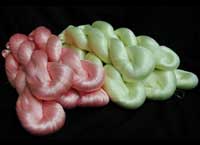Web Japan > Trends in Japan > Sci-tech > Fibers of the Future
Fibers of the Future
Groundbreaking Research Produces Highly Functional Silk
The world's first silks exhibiting fluorescence and other pioneering properties have been successfully developed as a result of transgenic silkworm research conducted by Japanese researchers. The feats were achieved by scientists at the National Institute of Agrobiological Sciences (NIAS) in cooperation with other organizations, including Toray Industries, Inc. and Tokyo University of Agriculture and Technology. The functional fibers, which are expected to have wide-ranging applications, are an extension of the institute's success in achieving the world's first genetic modification of silkworms in 2002.
Fluorescent Silk
Silk thread is made by pulling threads from cocoons made by silkmoth larvae (silkworms). Researchers have now developed three lines of transgenic silkworms. The first line produces silk threads that emit green, red, or orange fluorescent light. These threads were created by introducing into silkworm eggs genes that promote the generation of fluorescent proteins. NIAS has been able to achieve green fluorescence using genes extracted from jellyfish, a technique developed by Nobel Prize-winning chemist Osamu Shimomura, and red and orange fluorescence with genes extracted from coral, a technique that has already been used in commercial applications.
The introduction of these genes alone, however, produced only small cocoons with a low incidence of fluorescent proteins. The researchers overcame these problems by repeatedly crossing the fluorescent silkworm lines with ordinary silkworm varieties. Moreover, thread from silk cocoons is normally extracted by pulling thread from cocoons that have been placed in very hot water, but this heat destroys the fluorescent proteins. NIAS therefore developed a new means of extracting silk thread at low temperatures using alkaline agents.
The fluorescent silk threads have great potential for use in the fashion industry, and there is expected to be considerable demand for them from producers of high-end apparel. To promote this new material, NIAS displayed a dress, jacket, lamp shade, and other prototype products made with fluorescent silk at an autumn 2007 trade show in Tokyo. An increasing number of inquiries has been received from manufacturers and designers in the fashion business.
Finer Adhesive Properties
The second line of transgenic silkworm produces an ultra-fine silk thread. By introducing genes for producing especially fine thread into hakugin silkworms, which were already known for producing some of the finest silk of ordinary silkworm varieties, NIAS has developed a silkworm line that produces a thread even finer than that of ordinary hakugin silkworms. The unprecedented look and feel of fabric made from this type of ultra-fine silk makes it highly attractive to designers and producers of clothing and other fashion products.
Silk from the third line of transgenic silkworm exhibits high levels of cell adhesion - in other words, its cells are connected to each other rather than scattered. NIAS was able to generate this silkworm line by introducing genes that bolster cell adhesion. Thread made by these silkworms is expected to have applications in the field of medicine. NIAS is currently testing artificial blood vessels made from this thread, and other potential applications include the production of artificial corneas and artificial cartilage by cultivating cells on film made of this thread.
Despite these groundbreaking results, several issues remain. Areas in which further research is needed include changing the transgenic base sequences to improve the still-low incidences of the desired traits. Once these and other challenges are overcome, though, cultivation of these "fibers of the future" will become commercially viable. (February 2009)




